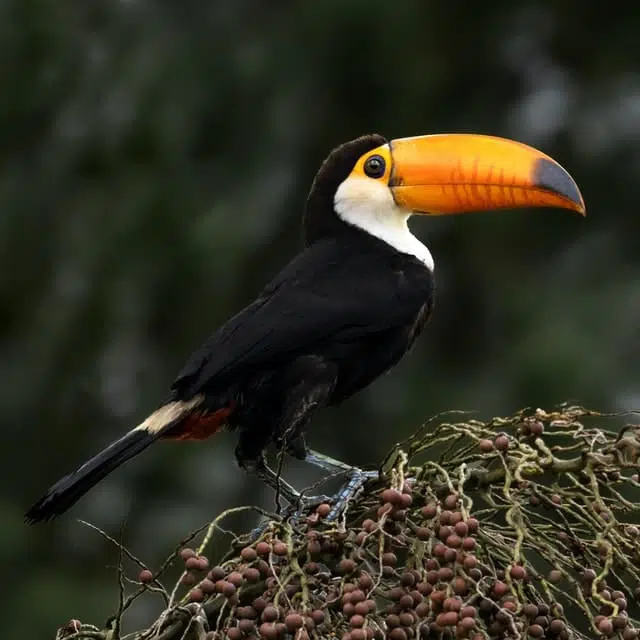Do you want to learn about the incredible animals and wildlife of South America?
South America is a continent that boasts a wide array of fascinating wildlife. Each country within its borders is home to unique and iconic creatures that are worth exploring. From captivating mammals to small omnivorous species, there is a lot to discover.

If you’re interested in observing wildlife, you can explore the neighboring lush rainforests and vast grasslands. Join us on a journey to learn more about the incredible biodiversity found in South America!
Click below to jump to any section on animals in South America:
Key Points
| Animal | Scientific Name | Habitat | Diet | Conservation Status |
|---|---|---|---|---|
| Maned Wolf | Chrysocyon brachyurus | Marshes, wetlands, grasslands, forests | Small mammals, insects, fruits | Near Threatened |
| Piranha | Pygocentrus nattereri | Lakes, rivers | Prey slightly larger or smaller than themselves | Varies |
| Caiman | Caimaninae | Streams, wetlands, lakes, mangroves | Aquatic animals, small mammals, birds | Varies |
| Guanaco | Lama guanicoe | Coastlines, plains, lower plateaus | Herbivorous, graze on grasses | Least Concern |
| Macaw | Ara | Rainforests, woodlands | Fruits, nuts, seeds, insects | Varies |
| Toucan | Ramphastidae | Tropical forests | Fruits, insects, eggs | Varies |
Maned Wolf
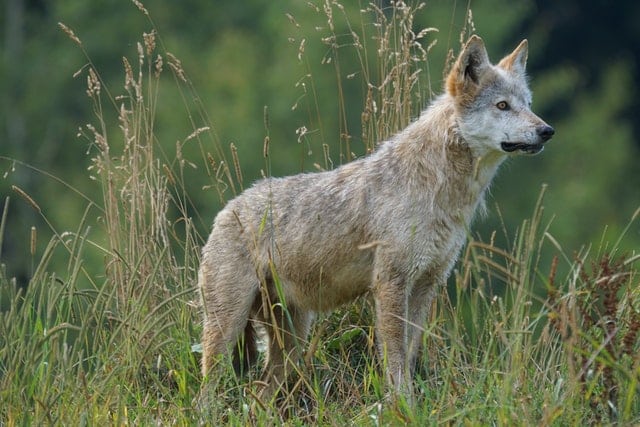
| Characteristic | Measurement |
|---|---|
| Scientific Name | Chrysocyon brachyurus |
| Size | Height: 90 to 100 cm (35 to 39 inches) |
| Length: 125 to 130 cm (49 to 51 inches) | |
| Tail Length: 30 to 45 cm (12 to 18 inches) | |
| Weight: 20 to 30 kg (44 to 66 lbs) | |
| Appearance | Reddish-brown coat with a black mane |
| Habitat | Grasslands, savannas, wetlands |
| Range | South America (Brazil, Paraguay, Bolivia, etc.) |
| Diet | Omnivorous |
| Plant Matter: Fruits, tubers, roots, sugarcane | |
| Animal Matter: Rodents, birds, fish, insects | |
| Behavior | Solitary, territorial, nocturnal |
| Vocalizations | Barks, howls, roars |
| Conservation Status | Near Threatened (IUCN Red List) |
The maned wolf is a fascinating creature known for its unique features. Its name comes from the distinctive mane on its neck that stands up when it senses danger. Its body is covered in long, reddish-brown fur, while its mouth, back, and tail are dark. Sometimes, you might spot white patches on its snout, chin, and throat. One of its remarkable traits is its long, almost black legs, which enable it to see above the tall grass as it runs.
The maned wolf has a diverse diet, including small mammals like wild guinea pigs, hares, young viscachas, and fast-running rodents like pacas and agoutis. It also consumes insects, reptiles, and birds as part of its regular meals. Interestingly, the maned wolf also includes fruits, sugarcane, and other plants in its diet. However, one of the biggest threats to the maned wolf is the significant loss of its natural habitat, primarily due to the conversion of land for agriculture. This habitat reduction poses a major danger to the survival of these remarkable creatures.
Where can one find a Maned wolf in South America?
They live in marshes, wetlands, grasslands, and wet and dry forests alongside other animals in South America.
Piranha
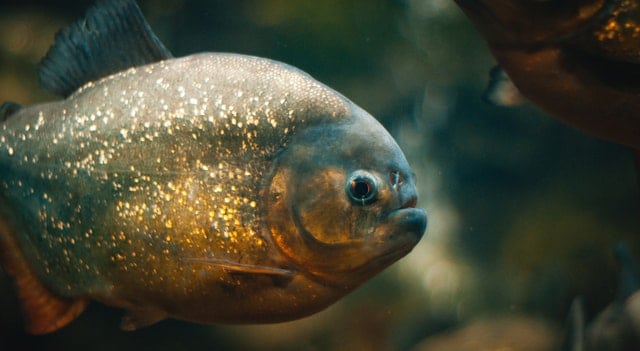
| Statistic | Description |
|---|---|
| Scientific Name | Pygocentrus nattereri |
| Common Name | Red-bellied piranha |
| Size | 10 to 12 inches (25 to 30 cm) (up to 16 inches/40 cm) |
| Weight | 2 to 3 pounds (0.9 to 1.4 kg) (up to 4 pounds/1.8 kg) |
| Body Shape | Deep, laterally compressed with rounded profile |
| Coloration | Silver to olive-green body with a reddish belly and fins |
| Distribution | South America (Amazon and Orinoco River basins) |
| Habitat | Freshwater rivers, floodplains, and lakes with vegetation |
| Feeding Habits | Carnivorous, feeding on fish, insects, crustaceans |
| Social Behavior | Often found in groups or schools |
| Reproduction | Egg-layers with external fertilization |
| Conservation Status | Least Concern (IUCN) |
Piranhas, known for their sharp teeth and fearsome reputation, come in various types. Most piranhas grow to about 60 cm in length and can have different colors, ranging from vibrant orange undersides to completely dark. These seemingly ordinary fish have unique bodies, with jagged stomachs and large, rough heads that house sharp, triangular teeth resembling a scissor-like bite. The Most Ferocious Freshwater Predator is the Piranha, and you can read more about is exciting excapedes with another one fo our articles.
Piranhas are found in a wide range from northern Argentina to Colombia, but the most diverse populations are found in the Amazon River, where you can find 20 different species. The red-bellied piranha is the most famous of them all, known for its strong jaws and sensitive teeth.
These red-bellied piranhas can grow up to 50 cm long, especially during periods of low water. They hunt in groups, sometimes numbering over 100 individuals. Occasionally, if they come across a large prey item, multiple groups may join in a feeding frenzy, although this is rare. Red-bellied piranhas prefer to target prey slightly larger or smaller than themselves.
Typically, a group of red-bellied piranhas spreads out to search for food. When one of them finds something to eat, it signals the others, most likely using sound since piranhas have excellent hearing. The entire group rushes in to take a bite, quickly swimming away to make room for others to feed.
Where can one find Piranha in South America?
About 30 species are found living in lakes and rivers of South America.
Caiman
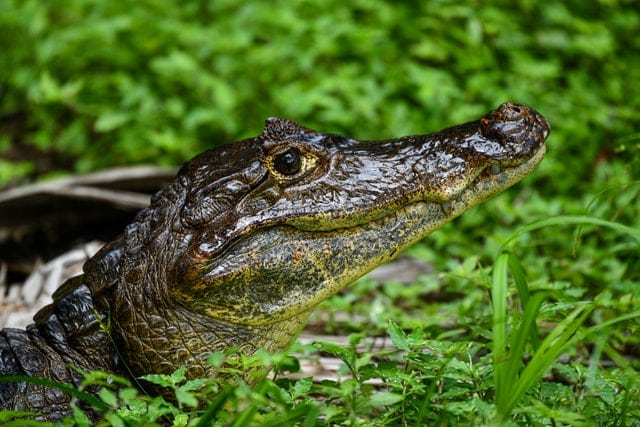
| Scientific Name | Caimaninae |
| Phylum | Chordata |
| Class | Crocodilia |
| Kingdom | Animalia |
| Statistic | Description |
|---|---|
| Scientific Name | Caiman (family: Alligatoridae) |
| Size | Varies by species; ranges from 1 to 5 meters in length |
| Weight | Varies by species; ranges from 6 to 450 kilograms |
| Habitat | Found in freshwater habitats like rivers, lakes, and swamps |
| Distribution | Native to Central and South America |
| Diet | Carnivorous, feeds on fish, amphibians, reptiles, and mammals |
| Lifespan | Varies by species; generally 20 to 40 years in the wild |
| Behavior | Generally solitary, but can be found in small groups |
| Reproduction | Internal fertilization; females lay eggs in nests |
| Conservation Status | Varies by species; some are listed as endangered or threatened |
Caimans are generally little individuals from the crocodile family tracked down in South and Central America. There are six unique types of this reptile. They are savage, sea-going hunters and, despite eating, they likewise chase little warm-blooded creatures, birds, different reptiles, and bugs.
Caimans are the same in appearance as crocodiles and gators. The typical length for most caiman species is around 6.6 – 8 ft. However, there are more modest bantam species, and the colossal dark caiman can arrive at 20 ft. Females will quite often be more modest than guys.
Caimans are generally dull earthy colors, grays, or greens to assist with keeping them covered while they are hunting. All of the caiman species have a hard edge that reaches out starting from the eyes and the nose, and they have huge eyes to assist them with hunting around evening time. Wild caimans are seen as commonly just in South and Central America.
However, caimans are also commonly kept as pets and can be found in zoos around the world. In some areas, they have escaped from farms or have been released by owners who couldn’t care for them properly.
Caimans face significant threats from human hunters who target them for their valuable skin and meat, as well as for collecting their eggs. This relentless hunting has greatly reduced the population numbers of certain caiman species. Additionally, they are vulnerable to deforestation and habitat degradation caused by human activities.
In some cases, caimans have been known to inhabit commercial fish ponds and livestock water sources, sometimes posing a threat to these animal populations. This can create challenges for local communities and wildlife managers in dealing with the conflicts that may arise.
Where can one find Caiman in South America?
Caiman is a marine reptile that live in streams, bogs, marshes, lakes, and mangroves. They, as a rule, incline toward still or gradually moving freshwater living spaces, yet a few animal types will endure quicker, saline. Or, then again, even saltwater environments alongside other animals in South America.
Guanacos
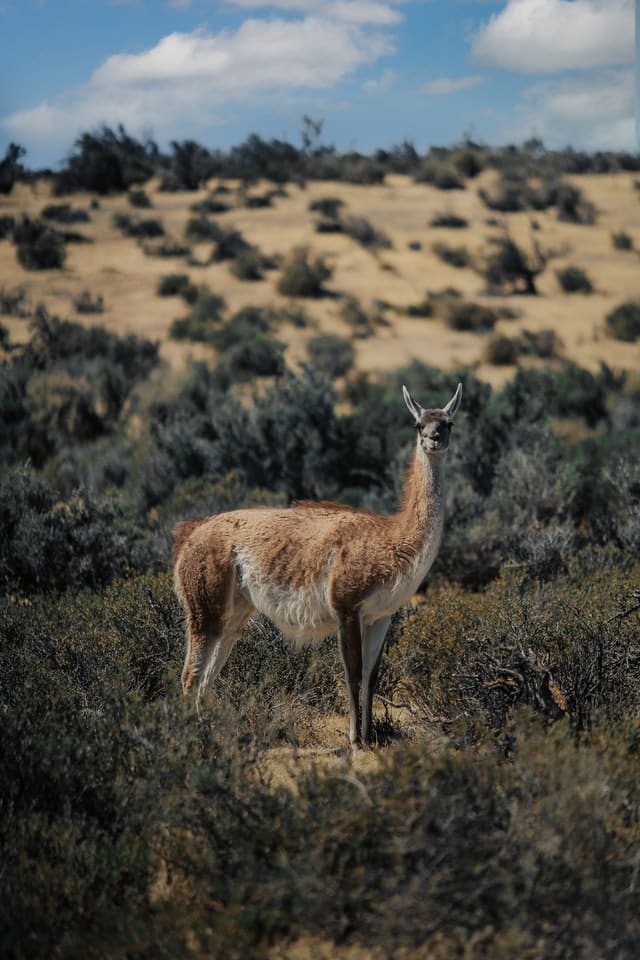
| Statistic | Description |
|---|---|
| Scientific Name | Lama guanicoe |
| Common Name | Guanaco |
| Size | 1.0 to 1.2 meters (shoulder height) |
| Weight | 90 to 140 kilograms |
| Lifespan | 15 to 20 years |
| Habitat | Native to South America, found in open grasslands and mountains |
| Distribution | Found in various countries including Argentina, Chile, Bolivia, Peru, and Ecuador |
| Diet | Herbivorous, primarily feeding on grasses and shrubs |
| Social Structure | Typically live in herds with a dominant male, females, and their offspring |
| Reproduction | Breeding season occurs in summer, with a gestation period of around 11 months |
| Conservation Status | Listed as “Least Concern” by the IUCN |
Guanacos, with their impressive features, have large eyes protected by thick lashes to shield them from dust and dirt stirred up by strong winds. They have prominent, pointed ears, but unlike camels, they lack humps on their backs. However, they share a similarity with camels in their feet.
Guanacos have two padded toes on each foot that help them maintain balance on rugged paths or rocky slopes. Their feet can be described as “soft.” These fascinating creatures usually live in herds. When they sense danger, such as from a mountain lion or fox, their best chance of escape is to run together as a group. This can confuse the predator, making it harder to focus on any individual guanaco.
They are native to Chile, which has a wide range of wildlife of its own. Read more about Chile’s wildlife with another oen fo our articles.
Despite their open habitat lacking hiding spots, guanacos have various ways of getting around. They are excellent runners, reaching speeds of up to 40 miles (64 kilometers) per hour, much like horses. Their soft-soled hooves provide traction on the gravelly terrain.
Baby guanacos, known as chulengos or guanaquitos, can run shortly after birth. Read more about cute baby animals with another post of ours! Guanacos are adaptable and can be found standing or lying in mountain streams. Whether they are walking, running, or even swimming, guanacos exhibit athleticism. Like all wildlife, guanacos have various ways of communicating, although some methods may be less pleasant than others.
Guanacos use different body positions to communicate. When their ears are up, it indicates relaxation. Ears pointing forward signal fear, while flattened ears indicate aggression. A downward-pointing tail is typical, a straight-out tail shows alertness, and an upright tail is an aggressive sign. Nose-to-nose encounters serve as a greeting, while crouching down indicates submission. Guanacos also communicate through vocalizations, ranging from high-pitched quavers to grunts and yells. Their alarm call resembles a mix of a cry and a laugh.
Where can one find Guanacos in South America?
They are found in coastlines, plains, lower plateaus, and other animals in South America.
Macaw
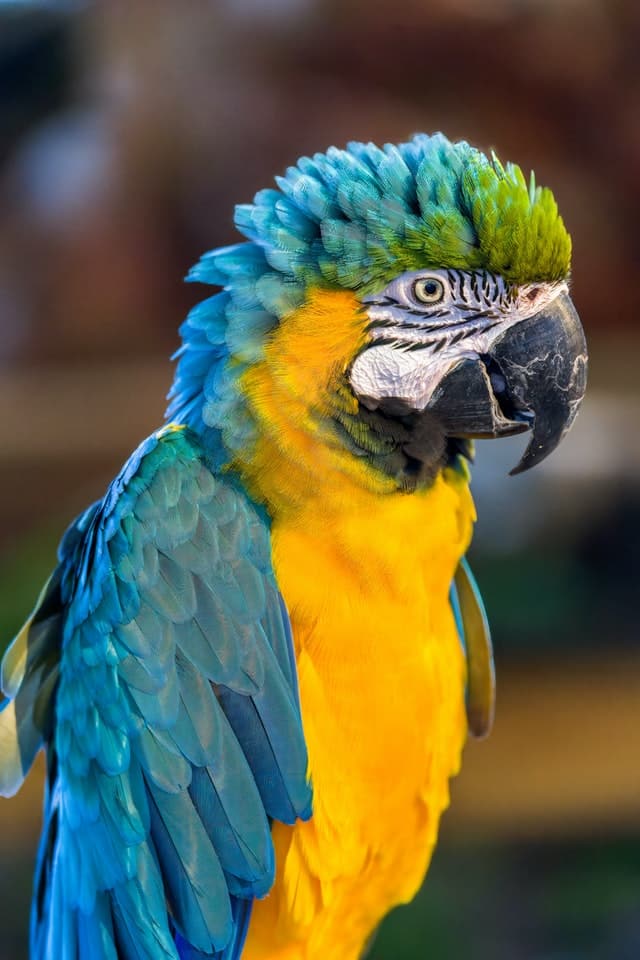
| Statistic | Description |
|---|---|
| Scientific Name | Family: Psittacidae; Various species within the family |
| Common Name | Macaw |
| Size | Varies by species; ranges from 30 to 100 centimeters in length |
| Weight | Varies by species; ranges from 900 grams to 1.5 kilograms |
| Lifespan | Varies by species; typically 30 to 50 years in the wild |
| Habitat | Native to Central and South America, found in rainforests and woodland areas |
| Distribution | Various species found in different regions of Central and South America |
| Diet | Omnivorous, primarily feeding on fruits, seeds, nuts, and vegetation |
| Feather Colors | Vivid and diverse; can include combinations of red, blue, green, yellow, and more |
| Social Behavior | Generally live in pairs or small flocks, highly social and intelligent |
| Reproduction | Monogamous; breed in tree cavities, laying 2 to 3 eggs at a time |
| Conservation Status | Varies by species; some are endangered due to habitat loss and illegal trade |
Macaws are known for their vibrant and colorful plumage, perfectly suited for their life in the tropical jungles of Central and South America, where lush green canopies and a variety of colorful fruits abound. These birds possess large, strong beaks that effortlessly crack open nuts and seeds. Additionally, their dry, scaly tongues have a bony structure inside, making them effective tools for grasping and manipulating fruits.
Macaws also have dexterous toes that help them grip branches securely while they grab, hold, and examine objects. Their elegant, long tails add to their majestic appearance. Macaws are highly intelligent and social birds that often gather in flocks ranging from 10 to 30 individuals. Their calls, screeches, and squawks echo through the forest canopy.
Macaws use vocalizations to communicate within their flock, establish territory, and recognize one another. Some species even exhibit the ability to mimic human speech. At night, the flocks rest in trees, and in the morning, they may fly long distances in search of fruits, nuts, insects, and snails.
Some macaw species also consume mineral-rich clay, which helps neutralize chemicals present in their fruit-based diet and aids in digestion. Macaws typically form lifelong bonds with their mates, engaging in breeding as well as sharing food and participating in mutual grooming. During the breeding season, while mothers incubate the eggs, fathers hunt and bring food back to the nest.
Sadly, several macaw species are endangered. These vibrant birds are highly sought after as pets, and many individuals are illegally captured for the pet trade. The destruction of their tropical jungle habitats is happening at an alarming rate. Species like the red-fronted macaw and blue-throated macaw are particularly threatened. The glaucous macaw and Spix’s macaw may already be extinct in the wild.
Where can one find Macaw in South America?
They can be easily found in rainforests and woodlands.
Toucan
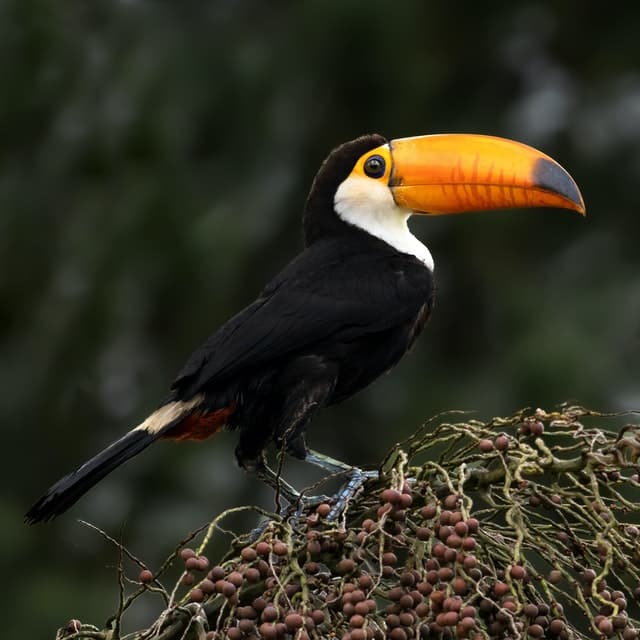
| Statistic | Description |
|---|---|
| Scientific Name | Family: Ramphastidae; Various species within the family |
| Common Name | Toucan |
| Size | Varies by species; ranges from 20 to 63 centimeters in length |
| Weight | Varies by species; ranges from 130 to 680 grams |
| Lifespan | Varies by species; typically 15 to 20 years in the wild |
| Habitat | Native to Central and South America, found in rainforests and woodland areas |
| Distribution | Various species found in different regions of Central and South America |
| Diet | Omnivorous, primarily feeding on fruits, insects, and small vertebrates |
| Bill Structure | Large and colorful, used for feeding, courtship, and display |
| Feather Colors | Often brightly colored, with combinations of black, white, red, yellow, and blue |
| Social Behavior | Generally live in small groups or pairs, highly social |
| Reproduction | Monogamous; breed in tree cavities, laying 2 to 4 eggs at a time |
| Conservation Status | Varies by species; some are listed as threatened or endangered due to habitat loss and illegal trade |
The toco toucan, the most critical and widespread species, is home in South America’s tropical woodlands. Its curiously large, bright bill has made it one of the world’s most famous birds: They’re recognizable business mascots, known for peddling strong, oat, and different items.
They can weigh almost two pounds and develop to 25 inches long, with their bill representing nearly 50% of their length. Native people groups respect the bird with a consecrated eye; they are customarily viewed as courses between the universes of the living and the spirits.
Both male and female toucans have enormous, bright bills. Their definite design isn’t straightforward. However, they’re accepted to assume a part in the courtship custom and with good reason. As a weapon, nonetheless, the bill is more show than substance.
It’s a lightweight honeycomb of keratin, a protein that makes up fingernails and horns, upheld by flimsy poles of bone. While its size might hinder hunters, it is useless in battling them. The toco toucan can likewise direct the progression of blood to its bill, permitting the bird to involve it as a method for conveying heat away from its body. The account helps take care of the hardware.
The birds use them to produce the natural sproducts on excessively few branches to help their weight. What’s more, the bill’s serrated edges help strip organic products. Notwithstanding natural sproducts like figs, oranges, and guavas, toco toucans eat bugs, eggs, and little birds of youthful birds. Toco toucans feed either separately or in little rushes in the overhang.
They will generally jump more than they fly. Their splendid varieties give great disguise in the dappled light of the rainforest overhang. The birds keep up a racket of vocalizations, fundamentally snorting and wheezing sounds that are frequently contrasted with the croaking of frogs.
These toucans home in tree pits and typically lay two to four eggs, which the two guardians alternate brooding. Youthful toucans don’t have an enormous bill upon entering the world — it develops as they create and doesn’t turn out to be the standard size for a considerable time.
Where can one find Toucans in South America?
They are found in lower altitude regions nearby other animals in South America.
Summary of Animals and Wildlife in South America
Each country takes pride in its unique animal species, ranging from fascinating mammals to small omnivorous creatures. If you’re interested in wildlife, exploring the nearby lush regions and vast grasslands is a great idea.
South America, in particular, stands out for its remarkable biodiversity, which can be attributed to its historical isolation during the Paleogene and Neogene periods. Many animals belong to exclusive groups, and even at the family level, there is a high degree of unique species found only in this region.
The process of speciation, where new species evolve, has been particularly intense in South America compared to other parts of the world. However, due to past geological events, there are also some similarities between the fauna of South America and that of other continents.
Ancient groups of animals, such as mollusks, chilopods (centipedes), certain fish, reptiles, and amphibians, share connections with the fascinating wildlife of Africa, Australia, and New Zealand. On the other hand, more recent species, primarily vertebrates, migrated from North America. Animals like armadillos, anteaters, porcupines, and opossums dispersed in both directions, enriching the biodiversity of these regions.
Thank you for reading Animals in South America! You can Discover Animals in the USA and read more about the Top 10 Animal Encounters in Europe with more of our featured blogs!
Frequently Asked Questions (FAQs)
Q: What countries are part of South America?
A: South America comprises 12 independent countries: Argentina, Bolivia, Brazil, Chile, Colombia, Ecuador, Guyana, Paraguay, Peru, Suriname, Uruguay, and Venezuela.
Q: What is the largest country in South America?
A: Brazil is the largest country in South America, both in terms of land area and population.
Q: What are some famous landmarks in South America?
A: South America is home to many iconic landmarks, including Machu Picchu in Peru, Christ the Redeemer statue in Brazil, Iguazu Falls on the border of Argentina and Brazil, the Galapagos Islands in Ecuador, and the Atacama Desert in Chile, among others.
Q: What languages are spoken in South America?
A: The most widely spoken languages in South America are Spanish and Portuguese. However, there are also significant populations speaking indigenous languages, as well as English, Dutch, and other European languages in certain regions.
Q: What is the climate like in South America?
A: South America has diverse climates due to its vast size and geographical features. It ranges from tropical rainforests in the Amazon basin to arid deserts in northern Chile, high-altitude Andean regions with cool temperatures, and the temperate climate of the southern cone countries.
Q: What are the major natural attractions in South America?
A: South America boasts incredible natural wonders, such as the Amazon Rainforest, the Andes Mountains, the Patagonian glaciers, the Amazon River, the Pantanal wetlands, and the diverse wildlife in the Galapagos Islands.
Q: Are there any endangered species in South America?
A: Yes, South America is home to numerous endangered species, including the jaguar, giant anteater, South American tapir, pink river dolphin, spectacled bear, and several species of macaws and turtles, among others.
- Top 10 Cutest Fish in the World - April 15, 2024
- 10 Most Endangered Animals - April 15, 2024
- 16 Top Predators in the Food Chain - April 12, 2024

